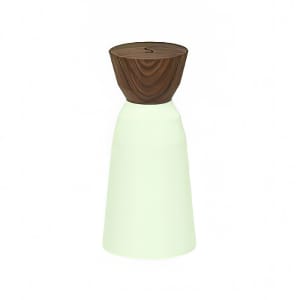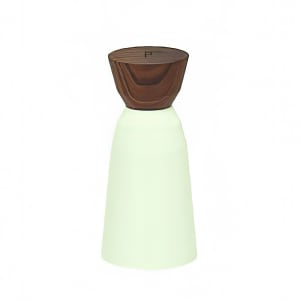Pepper Mills & Salt Grinders
Although pepper mills and salt grinders look similar, operators should never use salt in a pepper grinder or peppercorn in a salt grinder. More
Salt and Pepper Mills: What You Need to Know
The grinding mechanism in pepper grinders is made of a sturdy material that can withstand hard peppercorns, preventing users from grinding the smallware instead of the product. Grinding mechanisms are often infused with elements that form a hard outer layer, while salt grinders are designed with a grinding mechanism that is highly resistant to corrosion, suiting them to grind salt. Pepper mills are made with small and large grooves that line up peppercorns for proper cracking and refined grinding, while salt grinders crush dry salt to a desired consistency.
Operators should never use pepper in a salt grinder or salt in a pepper grinder. Salt grinders are not designed to crush peppercorns and salt can corrode pepper mill grinding mechanisms. Typically, pepper grinder mechanisms are prone to rust, which you can prevent by keeping the pepper mill dry and filling it with peppercorns only.
Constructed of a sturdy material that withstands hard peppercorns, the mechanism in pepper grinders prohibits users from grinding the smallware instead of the peppercorns. Salt grinders, on the other hand, are equipped with a corrosion-resistant mechanism, making them suitable for grinding salt. Additionally, salt grinders are built to crush dry salt to the desired consistency, while pepper mills' small and large grooves line peppercorns up for optimal cracking and refined grinding.
Salt can corrode pepper mills and salt grinders cannot crush peppercorns. However, there are salt and pepper grinders designated for handling both product at once. This smallware enables users to store salt and pepper in a single vessel and is optimal for tabletops with limited space. Salt and pepper mills range in height from 2 to 18 inches and are available in various colors to blend with a wide range of themes.
Smaller salt and pepper grinders are designed for tabletop placement, but larger configurations can be kept back of house. Servers can use the latter to grind salt and pepper for patrons at their tables. To further distinguish salt grinders from pepper mills at tables, smallware with clear bodies are available to give users a full view of the product each vessel contains.
Common Questions About Salt and Pepper Grinders
Where do you start when it comes to assembling a pepper grinder?
While different manufacturers construct various forms of pepper mills with different materials and designs, the basic setup generally is the same. Consult your manufacturer's instructions if this process doesn't work for you. The following guide is intended to help you get started.
Pepper grinders are simple pieces of equipment consisting of a long drive shaft secured to the head of the pepper mill. When turned, it rotates the grinding cutter within the female grinder at the bottom of the equipment. Begin by fully screwing the top knob onto the shaft; if the knob feels tight, run it on and off several times to clean the initially rough threads for smooth operation. Clean shavings from the thread with a wire brush to prevent later problems. Next, temporarily assemble the female grinder and spring bar, ensuring the female grinder seats into the spring bar's exterior grooves. Additionally, the female grinder should be oriented with the rounded inner edge facing down. Hold this assembly in its recess at the bottom of the pepper grinder's body, then center the assembly. Drill pilot holes for the screws that will secure it later.
How do you install a pepper mill drive plate?
To install the drive plate, fit the drive shaft through the hole in the turnplate and the hole in the pepper mill head. Slide the turnplate against the tenon on the bottom of the head. Center the shaft and turnplate on the tenon before drilling pilot holes for the screws that will secure it. After installing the screws, ensure the drive shaft passes through the turnplate and head without too much resistance.
How do you assemble the pepper grinder mechanism?
Slide the male grinder down the drive shaft – verifying the grinding teeth face up – then place the male grinder over the drive shaft. The rounded end of the internal teeth should face down, fitting over the grinder core. Put the spring over the drive shaft with the narrow end against the female grinder. Next, slide the spring bar down the drive shaft. Its sides should fit into the grooves of the female grinder. Place this assembly into the pepper grinder from the bottom, centering the spring and drive shaft retainer's screw tabs over the holes drilled earlier. Next, place the mechanism retainer over the assembly. The stepped side should face down and the mounting tabs should be centered over the screw holes. Install the retaining screws, snugging them down. They should be just tight enough to seat the mounting tabs fully to the pepper mill body.
Finish by slipping the pepper grinder head over the drive shaft's threaded end. Turn it so the shaft matches with the turnplate's hole. Slide the head down and insert the tenon into the body, ensuring the head is seated flush on the body. Screw the top knob onto the drive shaft and turn it down until it's snug against the top of the pepper mill's head.


